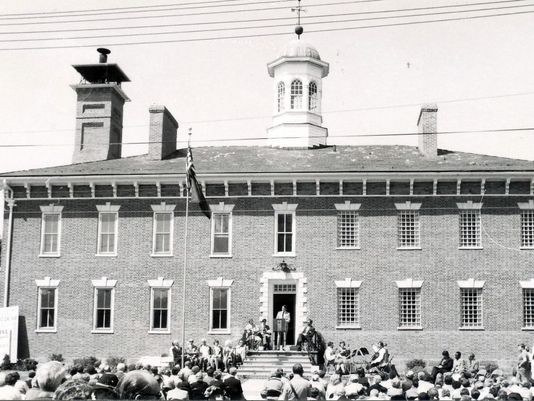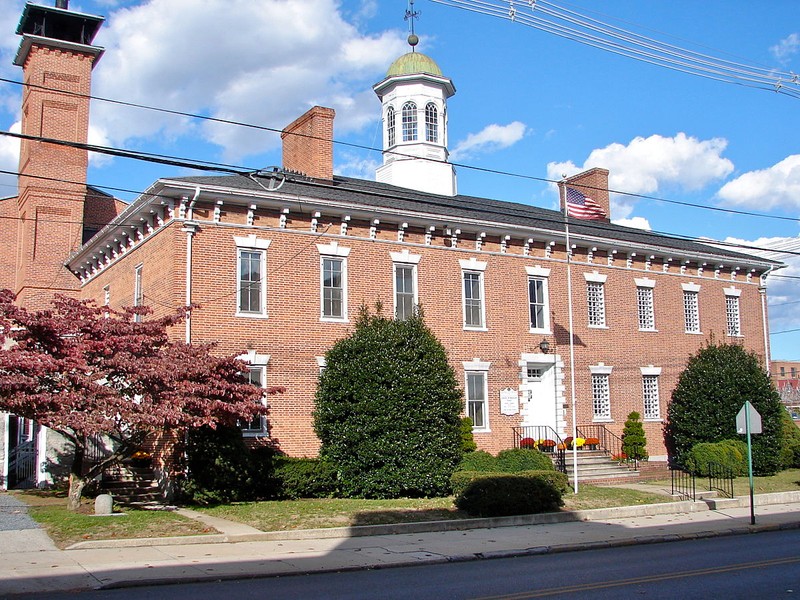Franklin County Historical Society-Kittochtinny and Old Franklin County Jail
Introduction
Text-to-speech Audio
Images
Dedication of the Old Franklin County Jail as the new home of the historical society in 1976. Courtesy of The Public Opinion.

Old Franklin County Jail in 2010. Courtesy of Wikipedia.

Backstory and Context
Text-to-speech Audio
The building that now houses the Franklin County Historical Society – Kittochtinny served as the Franklin County Jail from 1818 to 1971, during which time thousands of prisoners passed through its doors. At various times throughout its history, the jail served as the execution ground for three inmates, witnessed multiple successful escape attempts, and played host to a variety of debtors, thieves, abolitionists, and deserters. The county made alterations to the building twice over the course of the period: once to upgrade the facilities to include modern amenities during the American Civil War and again in the 1880s to add a new cell block. After the county jail moved to its current location at Franklin Farm Lane, the historical society assumed ownership of the old jail, converting a portion of its space into a museum and genealogical library dedicated to the study of Franklin County’s history.
Taking its name from the Lenape name for the Blue Mountain range that traverses the area (which means "endless hill,") the Franklin County Historical Society – Kittochtinny organized in 1898 at the suggestion of the Reverend Dr. S.A. Martin, then president of nearby Wilson College. In the over one hundred years since, the historical society has expanded to include the headquarters at the old Franklin County Jail (dedicated in 1976) and several other historic sites in the area, at each of which the society offers regular tours and outside of regular hours upon advanced request. The society also hosts regular events at its headquarters in the old jail related to local history and an annual haunted house in October at the same location.
The 1818 iteration of the Franklin County Jail was the third such building to serve as the area’s prison. In Chambersburg’s early years, the community kept its prisoners in a variety of locations depending on the severity of the crime: criminals punished for minor offenses generally remained imprisoned at John Jack’s Tavern across from the courthouse or in a log building on Main Street; more serious offenders wound up at the more secure facilities available in nearby Carlisle. In 1798, however, the county completed construction on a two-story stone building at the corner of Second and Market Streets known locally as the “old stone jail.” This structure quickly gained a reputation for overcrowded conditions, disease, and poor construction, criticisms to which the county responded with the construction of a second, more spacious, presumably more secure prison facility only twenty years after the completion of the first.
From the year of its construction to its last in operation, the Old Franklin County Jail confined thousands of prisoners. One such inmate, David “Robber” Lewis (known in his lifetime as the “Robin Hood of Pennsylvania” for doling out a portion of his ill-gotten gains to the less fortunate), spent a brief sojourn there prior to his eventual death in 1820 at Bellafonte Jail at the age of thirty. Another, Captain John Cook, was one of the men that took part in John Brown’s 1859 raid on the Federal arsenal at Harpers Ferry. Cook served as Brown’s spy in Harpers Ferry prior to the attack and was responsible for capturing Lewis Washington (George Washington’s grand-nephew) for use as a hostage the night before the raid was launched. Upon the raid’s failure, Cook made his way towards Chambersburg to retrieve his wife and child, becoming (behind Brown himself) one of the most wanted fugitives in the nation before eventually falling into the hands of a hunting party outside the town. Ultimately, Cook would be extradited to Virginia, where despite a last-ditch effort to escape execution with a full confession he met his end. Other prisoners that passed through the Franklin County Jail were more fortunate. A Union Army deserter escaped in 1863 with the help of a horse thief, for example, by breaking through an outer wall. Joseph Worthington, on the other hand, escaped from the prison four years later by setting up a pair of stuffed pants in his bed to fool the guards into believing he was still there. Most of the inmates, however, served their full terms, three until their execution by hanging on site.
The old Franklin County Jail is central to the area’s historical community not only as the historical society’s headquarters, but as a historic site offering a unique window into the nation’s early criminal justice system as well. Visitors to the site can learn about the history of the Franklin County area and research local families in the historical society’s museum and genealogical library. They can also take part in tours of the former prison facilities for more information on the history of the site itself. The building further serves as the venue for a variety of special events hosted by the Franklin County Historical Society – Kittochtinny throughout the year, from presentations on the history of the area to an annual haunted house. As both a historical site and the historical society’s headquarters, the old Franklin County Jail is therefore fundamental to historical interpretation in the area.
